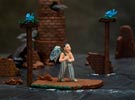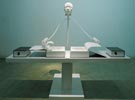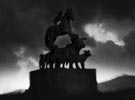In his recent works, the head portraits engraved and piled up closely by paper sheets layer by layer offset apparently, and in a constant state of compression and deformation in space. Li Hongjun uses multi deformative head portraits to hint that there exists a convertible and influential possibility between human brains and their cultures, which also shows that it is a long interactive process of culture, language, ideology and the brain structure of human beings.
On condition that Li Hongjun’s works of characters have more archaeological nature of cultural anthropologic and a reflection on the state of contemporary human subsistence, I appreciate more about Li Hongjun’s recent works “Empty Hall series”. In these works, Li Hongjun never shows us a head portrait of figurative, but digs up different kinds of streamline hole and cavity through the thick square papers, accordingly has strong sculpture characteristics of minimalism and futurism temperament. Apparently, these works has a long distance with human society, but this series draw our attention on the nature itself and let us see the rich visualization created by human beings and the internal heterogeneity isomorphy of natural substance existence. The streamlined form structure especially the negative space of hole and cavity just indicates that nature is the real demiurge of form. Artist is just the emissary of demiurge, and their works are not creature but discovery, that is, showing the concealed structure of world essence to us, unfolding the visual window which sinks into the secular life, taking us in a wonderful visual world. In my opinion, the blockbuster of "Avatar," "Pirates of the dream of space" in Hollywood just use science fiction to bring us into a wonderful trip of future world. You can also feel the strong fantastic atmosphere in Li Hongjun’s works, forgetting the trivial and boring secular society temporarily.
Since the Exhibition of Contemporary Art in 1989, I have always stressed the essentiality of the innovation of art language. In the real world, there is always a wide various issues which the artists in different fields such as literature, movie and drama as well as other categories face together, well, what are the special issues needed to be solved by visual artists? In my opinion, it is just the issues of art language. The discrepancy in contemporary art is a discrepancy in the expressing way of vision.
From the point of my view, Li Hongjun’s works discussed the contained “substance” through the usage of paper to express his observation and sensation of the whole world. Here, each individual imitation of objects is realistic, but the combination of different paper materials is subjective, works show Li Hongjun’s stirring independent consideration, that is, his cognition of discrepancy for human beings and nature, living supplies and art works. Human image interweaves with the creatures of himself in his works, but we would not consider the concealed Arcanum of existence because we are accustomed to see it in our daily life. However, Li Hongjun shows the most important invention “Paper” of human civilization in front of our eyes again after deconstruction, displacement and recombination, let us pays more attention and ponders to it when we are amazing.
Li Hongjun said: “The ultimate pursuit goal of artist is not ‘material’, but to achieve attention on the human spirit under ‘material’ form. So my greatest wish is to insist on my current creation ideas, seek expression in my vision, experience and knowledge, especially concern issues related to spiritual levels with my own vision and methods.” Li Hongjun’s series of paper installations, such as “Self”, “Inside and outside”, “Moved Paper”, “Empty Hole”, “Dilatant Paper”, etc, are all around a paper head-portrait, to explore the extreme of paper media cutting and three-dimensional sculpture. We can regard paper portrait as self-discussion, comparison and exchanges between self and virtual reality. Li Hongjun discovers a three-dimensional modeling language in engraving stack in paper-cut of Chinese folk art, focuses on the study of complex shapes, positive and negative forms, and the offset and overlapped image generated by cutting layers of papers.
Li Hunjun’s art removes the established form and returns to the origin of emotion, respects self-sense, opens mind space, reaches the reconstruction beyond media. His practice tells us that the concept of art resides only in practical object and it is realized by artistic hands. The artist’s cultural intuition is not only for material, but also for voluminous hand-made experience, they constitute an important aspect of art. Artists can reach the realm of ecstasy in the ongoing dialogue with the materials and production.
Since the 20th century, Chinese art has been using thought themes and social issues as its criteria of value judgment, the depth of theme interpretation and intensity of criticism are set as the criteria of value. Contemporary art since 1989 is a sensitive response to social change using modern art means and language. In judging the value of contemporary art works, we often wonder between artist’s social criticism point and language expression level. I have been expecting pure, technical and linguistic artists. Some would say there is no pure linguistic artist, art is something comprehensive. But we can not consider social, critical artists, about whose art media and linguistic skills we can’t talk.
Today Chinese contemporary art should bring up “experimentation” again. This experimentation is in terms of artistic expression, and in the level of artistic language and methodology. This is artist’s strength and the essence of his recognition in the art history. As Xu Bing said: “artist's skill is having an understanding of this era overstep that of most people, and knowing how to convert to a novel artistic language”.
Li Hongjun’s works show us new things with a trend, that is, the new generation of artists begin to walk out the map expression of ideology and grand narrative of nationalism, more submerging in the exploration of art language and experiments of new expressing techniques. After the first decade of the 21st century was over, facing the new decade, we look forward to the growth of a number of artists with truly independent creativity and artistic imagination, and expect them to go beyond fame and fortune, make some more interesting works. Today, facing the impetuous enthusiasm of contemporary art exhibitions, we need to return to art itself.
Oct. 19, 2010
Yin Shuangxi the Professor of Central Academy of Fine Arts, a Critic and Curator




